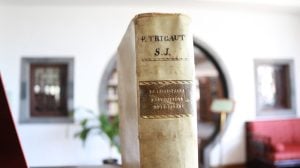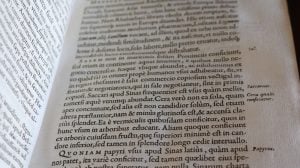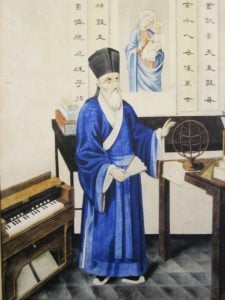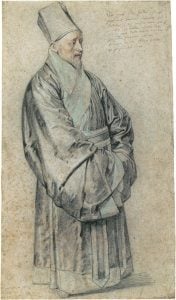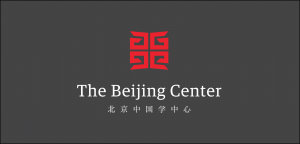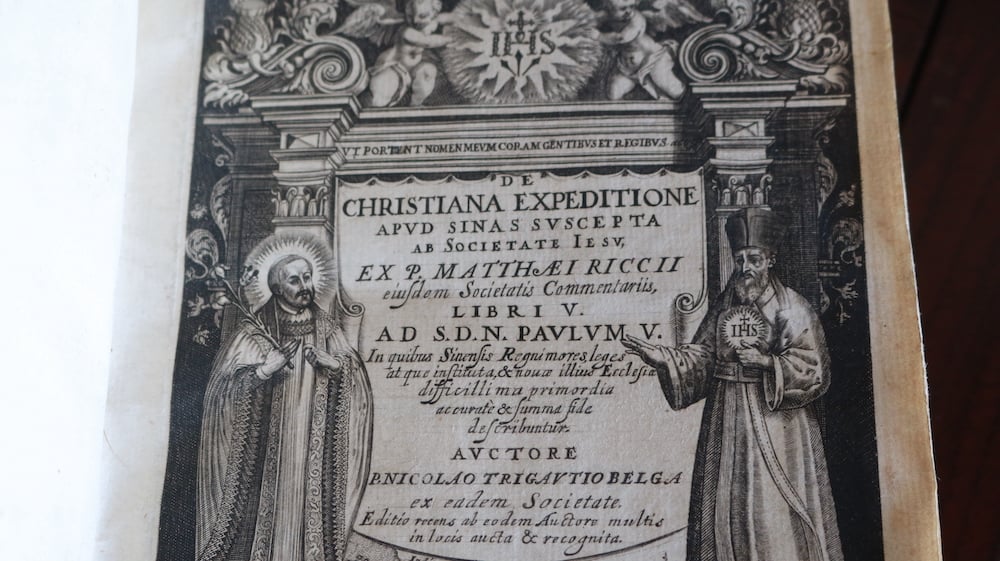
Matteo Ricci’s Journal
The Beijing Center’s Anton Library has almost 30,000 books in English on and about China. In honor of World Book Day 2023 yesterday, we’ll introduce you to a rare book in our collection:
Trigault, Nicolas and Ricci, Matteo. De Christiana expeditione apud
Sinas Suscepta ab Societate Jesu. Lugduni: Horatij Cardon 1616.
First-hand accounts from the Far East written by missionaries began to be published in the early 16th century and were soon followed by books dedicated exclusively to China. Later and to a much greater extent, the Jesuits were the authors of many of the books about China that were published in Europe in the 17th and 18th century and that not only were largely influential in shaping the perception of China in Europe, but also remain an important source of information today. The most important of these books might be De Christiana expeditione apud Sinas, better known as Matteo Ricci’s Journal, published in 1615 by Ricci’s fellow Jesuit Nicolas Trigault, of which we own a 1616 edition published in Lyon.
This is one of the most important and earliest works on China ever published in Europe. The earliest full account of the Jesuit China Mission, it contains the diary of the pioneer Jesuit missionary in China, Matteo Ricci, edited and brought up-to-date by Ricci’s co-worker in the Chinese Mission, the Flemish Jesuit Nicolas Trigault. Originally written in Italian, Ricci’s journal presents a history of the Jesuit mission in China from the time of Xavier to Ricci’s arrival in China in 1582, until his death in 1610, the same year in which Trigault arrived in Peking.
When Trigault returned to Europe in 1613, he translated Ricci’s manuscript into Latin and enlarged it with information from other sources. These sources included the accounts by the Italian Jesuits Niccolo Longobardo, Alfonso Vagnone, and Lazzaro Cattaneo of their experiences in China, as well as extracts from the usual Jesuit reports for the years 1610 and 1611 by Father Sabatino De Ursis and others. Trigault’s book made a huge impact on cultural life and philosophical thought in Europe. Never before had such well-organized and accurate information about China been made available. The book opened up for Europe a new, mysterious, and until then virtually unknown world.
It was an immediate success in Europe and versions were soon published in German, Spanish, and Italian, the original language of the journal. A complete English translation of Trigault’s work was not available until Louis Gallagher’s translation, China in the Sixteenth Century: The Journals of Matteo Ricci: 1583-1619. Translated from the Latin was published in 1942 and again in 1953, although there was a partial translation in 1625. The introductory chapter to Ricci’s Journal added by Trigault was published separately in English in 1942 as China That Was: China As Discovered by the Jesuits at the Close of the Sixteenth Century. A modern Chinese version was published in 1986.
Authors:
Ricci, Matteo, 1552-1610
The most illustrious of the early Jesuit missionaries of the China Mission, Ricci was born in Macerata, Italy. He became friends with many Chinese, especially those of the literati class, who admired his maps of the world, his erudition, memory techniques, and friendly disposition. On his part, Ricci studied the texts of Chinese scholars. He also translated into Chinese many Western scientific and classical works, such as Euclid’s Elements, and famous aphorisms on friendship. Ricci is widely considered the founder of Western sinology. He died in Beijing on May 11, 1610. After his death, the Emperor granted the Jesuits the Zhalan cemetery and commissioned a magnificent tombstone that still survives today. He remains among the most famous Westerners in China, and may be considered “the most outstanding cultural mediator between China and the West of all time.”
Trigault, Nicolas, 1577-1628
Born in Douai, Belgium (now French Flanders region), Trigault was a Jesuit missionary in China. He traveled extensively in Europe to get support for the China mission and also played an important role in acquainting the western world with Chinese culture. He arrived in China in 1610, preaching in Nanjing and Hangzhou. Two years later, he was sent back to Europe to present a report. On his return journey, he translated Matteo Ricci’s posthumous Italian manuscript into Latin and wrote his famous History of Christianity in China based on Ricci’s material. During his sojourn in Europe, Trigault introduced Chinese culture in many lands, even as he raised funds and gathered thousands of books for his second visit to China in 1618. Most of the several thousand books he brought to China were on theology and science. Others concerned philosophy, literature, and the arts. He wrote a book titled Xiru ermu zi (An Aid to the Eye and Ear of Western Scholars), written primarily to help Western scholars learn and pronounce Chinese characters. Previously Matteo Ricci had written Xizi qiji (The Wonder of Western Words), which aroused great admiration among his fellow scholars. Trigault’s book made an equally great impression on the literati of the time and had a definite influence on Chinese scholars of phonology. Trigault was also the first European to see the Nestorian monument of 781 in Shaanxi Province. He died in Hangzhou.
TBC’s online database is available in both English and Chinese, and can be accessed at library.thebeijingcenter.org. The historical collection’s highlights can be browsed here.
By Rachel Liu, TBC Intern



